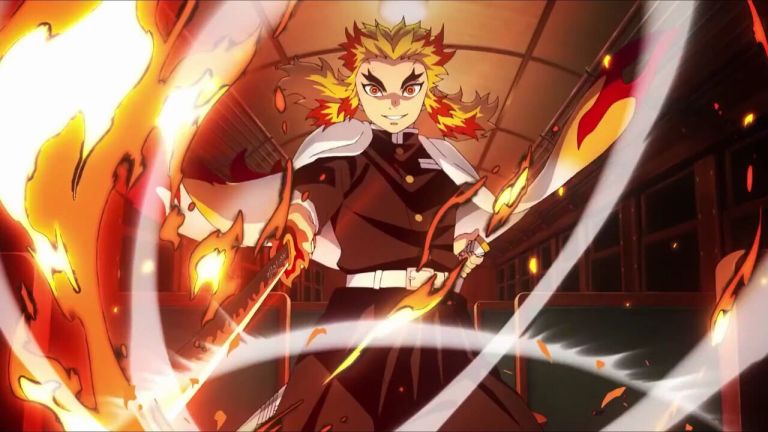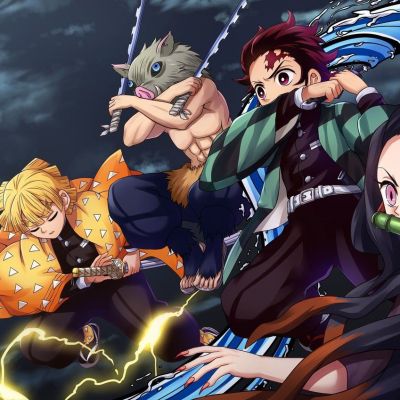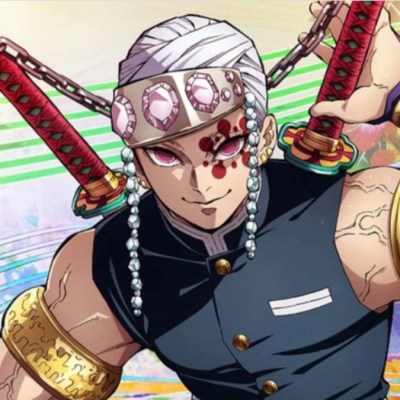Demon Slayer the Movie: Mugen Train Review – Anime Hit is a Smooth Ride
Demon Slayer’s first movie is an action spectacle with dazzling animation that puts Tanjiro and company in their biggest adventure yet.

“No matter how many precious lives the demons take…A strong will can never be taken.”
It’s become a common tradition for the most popular anime series to get theatrical adaptations. It’s not surprising then that Demon Slayer: Kimetsu no Yaiba is the latest to make this leap considering the tremendous success of the anime and manga. These cinematic endeavors can sometimes be a mixed bag due to a tendency to function as recap compilations or entertaining sagas that ultimately become unnecessary filler in the context of the anime.
Demon Slayer’s movie, Mugen Train, chooses the best route possible here with a narrative that’s a direct sequel to the events of season one and an important action-filled bridge to the events ahead in season two. This approach has paid off in a very big way since Demon Slayer the Movie: Mugen Train has gone on to become the most successful animated movie to ever be released in Japan, surpassing Hayao Miyazaki’s Spirited Away. This creates extremely high expectations and while Mugen Train is unlikely to get nominated for an Academy Award, it’s still an entertaining movie that marks a high point for the medium.
Demon Slayer’s anime leans into traditional archetypes of the genre with a budding hero’s journey to become stronger, realize his potential, and conquer the monsters that have afflicted his family. Mugen Train is absolutely meant to be experienced by fans of the series, but it’s not so inside baseball that it’s imperceptible to an outside fan. The movie does a reasonably good job covering the basics of the series in a way that doesn’t feel like shoehorned exposition or a clumsy introductory sequence.
Mugen Train’s success as a viewing for both Demon Slayer devotees and virgins is also due to the streamlined nature of the movie’s plot. The major conflict is that Tanjiro and his demon slayer team board a suspicious locomotive where a slew of people have gone missing from alleged demon activity. That’s it. It’s not a lot to break down and it allows the movie to celebrate its action sequences and how to bring them to life in the most exciting way. The animation and fight choreography are undoubtedly the most exciting aspects of Mugen Train, but that doesn’t mean that other areas like characterization are totally shallow. It’s style over substance, but not in a way that robs the characters of depth.
Mugen Train doesn’t waste any time. It quickly identifies Enmu, the Lower Demon Moon member that wreaks havoc on the train, as well as Rengoku, the Flame Hashira that’s supposed to aid Tanjiro on this mission. Mugen Train really becomes more of a story for Rengoku than anyone else. He shares the spotlight with Tanjiro, but Rengoku has more to both lose and gain through all of this. Rengoku was previously introduced in the anime, but Mugen Train is his real showcase and origin story. This focus on Rengoku doesn’t come across as jarring and Tanjiro’s growth is able to compliment Rengoku’s mission in a way where their purposes diverge. There is even a huge Agatha Christie-esque twist around the central premise, but it applies such an exaggerated anime slant to the staple.
Rengoku’s excitable, gung ho energy basically powers the movie and keeps everyone moving forward. Mugen Train is very well-paced at under two hours and it feels like it constantly has action on the screen. Enmu is also a genuinely terrifying villain that feels a cut above what’s seen in the anime. He utilizes a disembodied talking hand to do his grunt work that feels like a more disturbing version of a Jujutsu Kaisen set piece. Demon Slayer has always been more of an action series than a horror showcase, but it’s appreciated that Mugen Train experiments with these darker visuals and ideas.
On this note, Enmu has a Freddy Krueger-like quality that forces the heroes into surreal dreamscapes. This aesthetic allows for justified “flashbacks” as characters spend time in idealized versions of their lives with relics of the past. It works as a believable way to juxtapose Tanjiro’s old self with what he’s become and if he’s willing to continue to move forward even if it means that he also moves further away from the version of himself that left home. The nature of these dreams also allows the settings for these fights to become much larger and more creative than the narrow hallway of a locomotive, even though they’re still contained to the vehicle.
The actual battles with Enmu are what everyone will be talking about afterwards. Ufotable has only become a more accomplished animation studio, but the climax of Mugen Train’s main battles easily trumps the anime’s most thrilling showdowns. The flame and water displays from Tanjiro and Rengoku look gorgeous, but there are so many precise details that make these fights feel special. Rengoku and Tanjiro do much of the heavy lifting, but the entire cast get moments where they’re allowed to kick ass, even Nezuko. There’s even a very Junji Ito and Akira quality to the level of bleak grossness that these demon slayers face in the movie.
These fight sequences incorporate many CG elements, which is something that could sometimes be awkward in the anime series. Mugen Train rises above this previous hurdle and there’s a sublime seamless blend of 2D animation with 3D assets and compositing. It even feels like there’s subtle rotoscoping in scenes of nature where certain environments and backgrounds look borderline real. This is also present with the movie’s titular train, which also acts as such a big spectacle.
Mugen Train makes the locomotive feel extraordinary through long and sprawling shots that highlight its sheer size and power. This wonder is also present in the characters themselves and it’s endearing to see characters like Zenitsu often freak out over the fact that they’re on a train at all as they try to orient themselves around this mechanical feat. It’s true that a steam engine seems as foreign to these characters as a demon would have been at the start of the series and it helps make the movie’s claustrophobic setting gain significance and contribute to the growth of these characters and not just function as an atypical location for action.
Demon Slayer’s anime has always featured strong music to go along with its visuals and Mugen Train is no exception. Go Shiina and Yuki Kajiura deliver numerous numbers with operatic qualities to them that help make the final fight feel like a fated battle between Gods. LiSA’s end song, “homura,” is also an emotional pressure release that helps Mugen Train’s emotional final act sink in.
Demon Slayer the Movie: Mugen Train is available with both subtitles as well as an English dub. Both of these versions are exceptional, but there’s nothing lost in the dub and it’s clear how much work went into this production. Mark Whitten returns as Rengoku, but has a lot more to do here than he ever did in the anime series. The full nature of Rengoku’s character comes to light and Whitten’s work allows this Hashira member to feel complex and not just some enthusiastic blade-wielding hero. It’s easily one of Whitten’s most commanding performances. Landon McDonald (perhaps best known as Rampo Edogawa from Bungou Stray Dogs or his recent turn as the titular protagonist in the JoJo OVA, Thus Spoke Kishibe Rohan) is also fantastic casting for Enmu, which allows McDonald to show off his naturally gruffer vocal tones, but still tap into the more innocent side of this demon.
Much like the Demon Slayer anime, some may dismiss Haruo Sotozaki’s Demon Slayer the Movie: Mugen Train as hollow entertainment. It’s a big animated action blockbuster that trades in extravagance, but every frame of Mugen Train is packed with passion. This film is such a thorough love letter to both the anime and its fans. It has much more to offer than flashy action, even if that’s the movie’s focal point.
Mugen Train succeeds as both entertainment where you can shut off your brain as well as an emotional story in which individuals push themselves past their breaking point. Die hard fans of the anime will likely even shed a tear. In terms of first films, Mugen Train establishes a very high benchmark to surpass in the future. It’s not just a satisfying Demon Slayer movie, but it’s a triumph of animated cinema, period.
Demon Slayer: Kimetsu no Yaiba: The Movie: Mugen Train is playing in select theaters on April 23rd.


